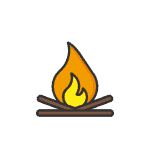A weekend camping trip with the family shouldn’t cause you to clutch your wallet and shutter with panic. Camping isn’t supposed to be that expensive. However, if you’re finding that it is, then you’re probably doing it wrong!
Yes, there are gadgets and gizmos to spend a small fortune on, but you really don’t need to burn through a wad of cash to enjoy the great outdoors.
So, to make the most out of your next camping trip, and to help save a few dollars along the way, here are 8 money saving tips that can add up fast!
1. Maximize Campsite Capacity
Most campgrounds limit the number of campers per campsite. This ensures there are adequate amenities for all and helps preserve the natural beauty of the campground.
However, a great way to cut costs is to maximize the campsite capacity during your stay. By doing this, you can split the camping fees as well as the cost for supplies and transportation amongst more people. It’s so simple, but often overlooked!
So, when planning your next trip, make sure to look up the campsite capacity. Then, see if others might be interested in camping with you. You get to enjoy the outdoors with some good friends, and save money camping. Win-win!
2. Stop Using Disposable Propane Bottles
Odds are that your camp stove is fueled by propane. And, since they’re ultra portable, you’re probably using small, disposable 1 lb propane bottles. These bottles can be purchased at your local outdoors or hardware store, making them very easy to find and purchase.
However, depending on how much you end up cooking, you can cycle through a few of these bottles in one camping trip. A three pack of these bottles costs $20, which works out to be $6.67 per pound.
A much cheaper alternative is to bring a large propane cylinder. Propane cylinders can also be purchased at outdoor and hardware stores, as well as some gas stations. A 20 lb propane cylinder usually costs $50, which works out to be $2.50 per pound. This is over 2.5 times cheaper than propane bottles!
Not only will you save tonnes of money camping, your propane supply lasts much longer. You can plan longer camping trips and, when the propane runs out, you can recycle the cylinder instead of trashing it. It’s a better choice financially and environmentally!
Pro tip: If you end up bring a propane cylinder, make sure you bring a high pressure propane hose and adapter. This lets you connect directly to your camp stove!
3. Buy Used Camping Equipment
Like many before me, when I first got into camping, I purchased all new equipment. I quickly found out that brand new, high quality equipment comes at a premium price. And, since I was a broke-ass high school student at the time, my purchases became few and far between.
Nowadays as an aspiring adult, albeit less broke-ass, I scour newspaper classifieds, garage-sales and online gear swaps for gently used camping equipment.
I find that a lot of gung-ho people [like my sister in-law] end up purchasing brand new, high end equipment thinking they’re going to scale mount Everest. When, in fact, the only Everest they end up with is a pile of unused gear collecting dust in a storage locker.
So, when those people end up clearing out their closets (probably to fill with their next would-be hobby) you can capitalize. You can save hundreds, maybe thousands of dollars. Used tents, sleeping bags, backpacks, mattresses, even boots can be in great working order and can last a lifetime.
Besides Craigslist and Kijiji, check out MEC Gear Swap, or visit your local second hand stores and pawn shops.
Pro tip: You can also purchase slightly damaged equipment at a much lower cost and repair it yourself. Check out my DIY article for all sorts of tent repair tips [How to Repair a Damaged Tent (Quickly & Easily)] .
4. Rent Gear If You Don’t Camp Often
For a novice camper, initially purchasing all the necessary equipment can be quite expensive. Even buying used gear can add up fast. But, if you want to test out camping or camp infrequently, renting gear makes more economic sense.
However, many outdoors and outfitting stores rent equipment at really affordable prices. You can rent pretty much everything you need for a typical camping trip. From tents and sleeping bags, to cookware and chairs! You can also purchase complete camping kits, which take the guess work out of remembering what to bring.
So, for example, let’s say you’re ready to go on your first 3-day weekend family camping trip but have no gear. Obviously, the first thing you’ll need to bring is a tent. A brand new 4-person tent will set you back $350 crisp Canadian dollars.
However, if you rent that exact same tent it’ll cost you $15 per night! That’s a grand total of $45 dollars for 3 nights. That means you’ll need to go on over 7 trips in the future to make purchasing the same tent worth your while! What seems practical to you?
Renting equipment can save you tonnes of money especially if you’re just getting into camping or looking for specialized gear for special occasions (e.g. festival camping). Save your money and rent; it just makes cents [sorry, terrible pun].
Pro tip: Check out equipment rental costs at these outdoor equipment supply retailers:
https://www.algonquinbound.com/rentals/camping-gear-rental.html

5. BYOF - Bring Your Own Firewood
Every camping trip isn’t complete without a roaring camp fire. Roasting and eating marshmallows, listening to the crackle of the logs, and feeling the glow of the ambers is very comforting. And for some campers, every night needs a fire.
Obviously the main thing you need for a fire is wood. Conveniently, most campgrounds have firewood for sale at the ranger station. The price is typically $10 for a bundle and one bundle usually lasts one night.
However, if you want to save a little extra money, you can bring your own firewood. Driving up to a campground, many shops and locals tend to sell the same bundles of wood, sometimes at half the cost! If you’re camping for an extended period, the cost savings can really add up.
A word of caution though. Invasive pests and insects are a huge problem in some jurisdictions. So much so that some parks do not permit the use of wood not local to the immediate area. So, only use local wood. And if you don’t end up using all your wood, leave it for the next visitors to use.
Pro tip: Have you never made a camping fire before? It’s so easy and fun to do!
Check out my article How to Build a Fire for a step-by-step guide so you can enjoy this camping tradition.

6. Stop Buying Pre-Packaged Meals
I’ll admit, I don’t necessarily enjoy meal planning for camping. Ensuring I cook and eat enough calories, especially for strenuous trips, takes a bit of effort and planning beforehand. However, I’m always happy I do because the last thing I want to think about while I’m in the woods is if I’ve brought enough food.
However, some campers take the guess work out of meal planning by just purchasing ready-made, pre-packaged meals. While they’re incredibly simple to prepare (just add boiling water for most), they are loaded with salt and never seem to fill me up with one package.
They’re also deceivingly expensive. A standard pouch of dehydrated rice and chicken is a whopping $12… before tax! So, for a solo 3-day camping trip, based solely on packaged meals, you’ll end up spending a minimum of $100 for 3 square meals a day. Yikes!
On the other hand, bringing bulk grains, fresh or dehydrated vegetables, frozen/fresh or canned meats, and your own spices, you can save a lot. An easy, inexpensive meal are wraps. The total cost for the wraps, including canned chicken, vegetables and spices is typically less than $5 per meal!
Now that’s savings you can take to the bank. Literally!
7. Freeze Bottles of Water for Ice
Although ice isn’t the most expensive item to purchase, a great way to save a few extra dollars while camping is to freeze bottle water at home.
Frozen bottles can then be placed in your cooler, keeping the contents cool. And, as soon as the ice melts, you’ll have clean and fresh drinking water.
Bags of ice, since they have lots of surface area, tend to melt away quickly. And, you’re left with a water-filled cooler that you need to constantly empty.
Pro tip: Freeze water bottles of different sizes. A few 500 mL bottles, and some large 1L bottles is a good idea. The larger bottles stay frozen longer, but the smaller ones can squeeze into smaller pockets in your cooler!
8. Pack Drinks and Food in Separate Coolers
If you plan on drinking while camping, both the alcoholic and non-alcoholic variety, two coolers is a game changer.
Why? Well, think about it. How often would you open a cooler to grab a beer or a pop? Once a day? Twice? Maybe 7? I’m not judging…
But seriously, every time you open a cooler, you let the cold air escape and warm air in. Obviously, and logically, a cooler that’s been opened more frequently will have its ice melt faster.
So, to preserve your ice, bring two cooler. One for food, and one for drinks. Your food will stay fresh longer with less ice, and you can grab a drink worry free. Well, unless you’ve got a Karen at your campsite.
This article contains affiliate links, which help support this blog at no cost to you!

Hella helpful post there, some awesome tips and links.